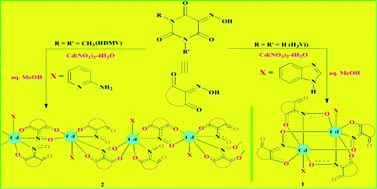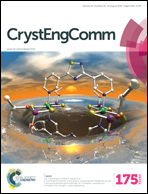Two mixed-ligand cadmium(ii) compounds bearing 5-nitrosopyrimidine and N-donor aromatic blocks: self-assembly generation, structural and topological features, DFT studies, and Hirshfeld surface analysis†
Abstract
Using the mixed-ligand strategy, two novel cadmium(II) coordination compounds, namely, the discrete 0D dimer [Cd2(μ2-H2Vi)4(benzim)2]·2MeOH (1) and the 1D coordination polymer [Cd(μ2-DMV)(DMV)(2-apy)]n (2), were self-assembled in aqueous methanol medium under ambient conditions from the cadmium(II) nitrate–H3Vi/HDMV–benzim/2-apy system {where H3Vi = violuric acid [5-(hydroxyimino)pyrimidine-2,4,6(1H,3H,5H)-trione], benzim = benzimidazole, HDMV = N,N′-dimethylvioluric acid [5-(hydroxyimino)-1,3-dimethylpyrimidine-2,4,6(1H,3H,5H)-trione], and 2-apy = 2-aminopyridine}. Both products were isolated as crystalline solids and were structurally characterized. The violurate ligands adopt a tridentate bridging mode in 1, whereas in 2 simultaneous coordination modes [bis(bidentate) bridging + bidentate] are displayed by dimethylviolurate ligands. The nature of the substituent on the violurate ring and the presence of different N-donor ligands play a role in the generation of distinct products. The crystal structures of 1 and 2 reveal a number of strong intermolecular hydrogen bonds that are responsible for the 0D → 3D (1) or 1D → 2D (2) structure extension, resulting in rather complex H-bonded networks. These networks were topologically classified as underlying nets with the sqc2 and 3,4L18 topologies in 1 and 2, respectively. By means of DFT calculations (BP86-D3/def2-TZVPD), the computation of the energetic features of the different noncovalent interactions, such as lone pair (lp)–π, π–π, and C–H/π, was performed aiming at rationalizing their roles in the crystal packing of 1 and 2. Notably, the lp–π interactions observed in 2 present one of the shortest lp–π distances (2.74 Å) reported to date. Hirshfeld surface analysis was also carried out to provide qualitative and quantitative insights into the intermolecular interactions in 1 and 2. Furthermore, luminescence properties of the compounds were investigated.



 Please wait while we load your content...
Please wait while we load your content...